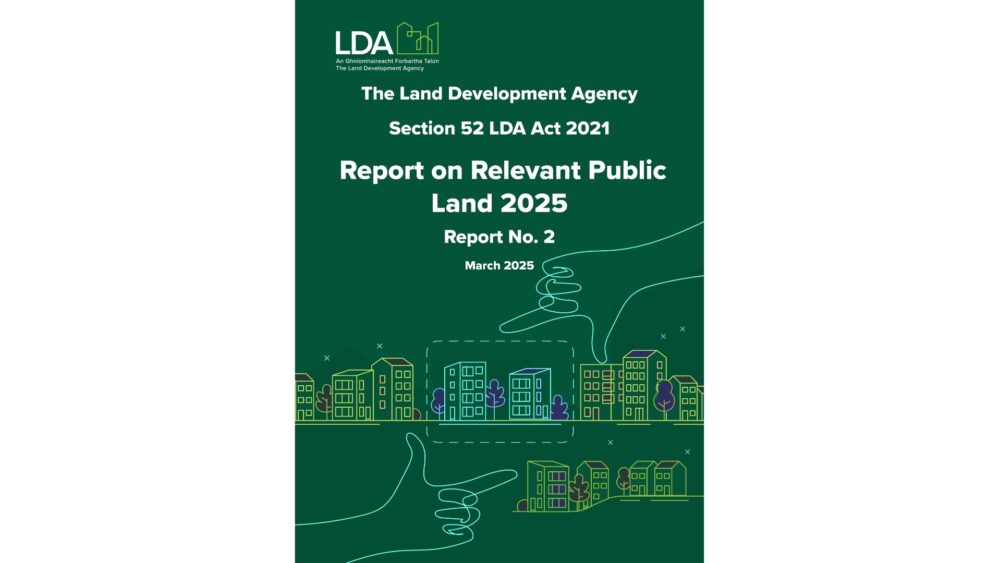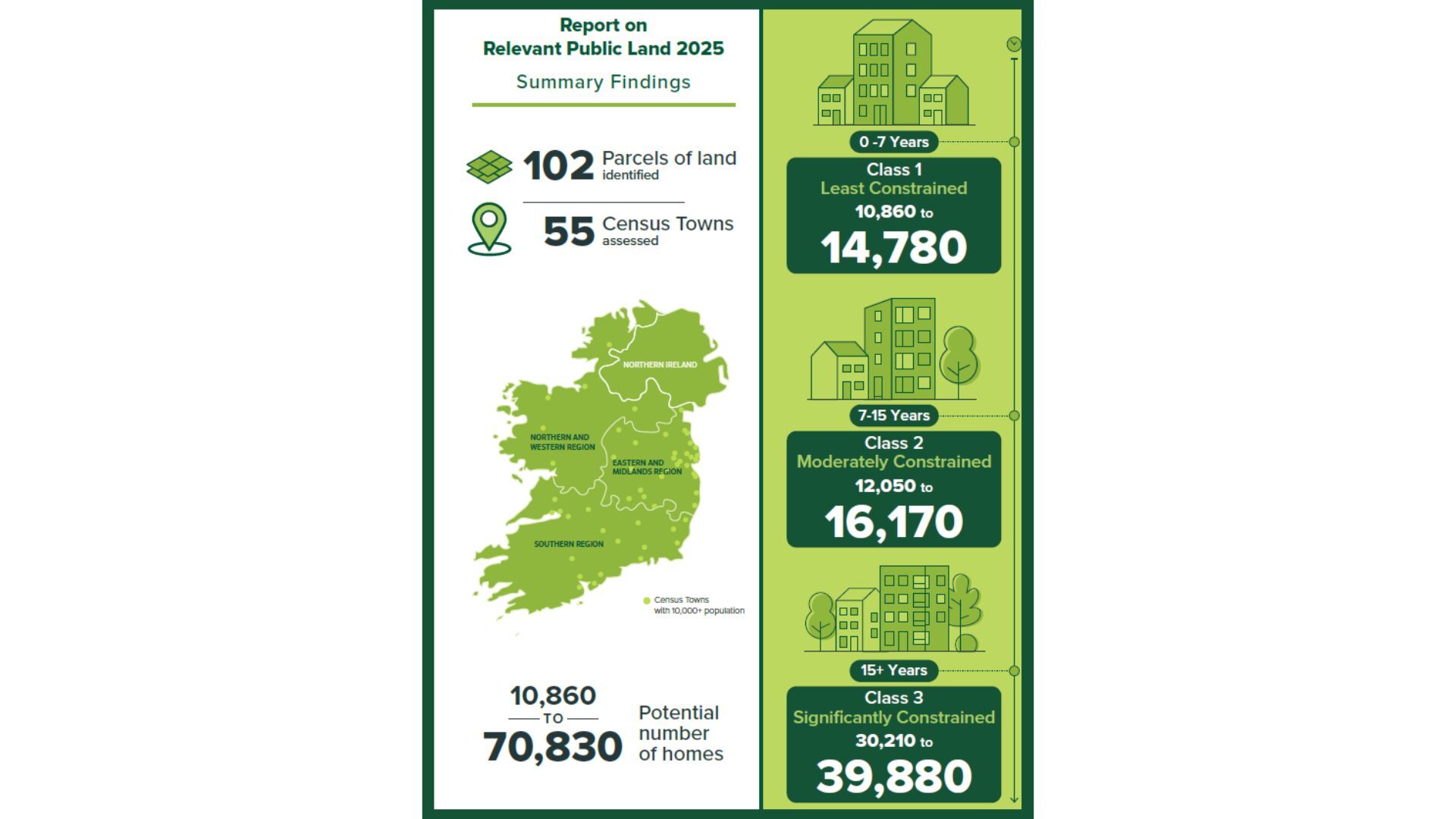Almost 15,000 homes could be delivered on ‘least constrained’ State-owned land in short to medium term, new LDA report finds
- An additional 56,000 affordable homes could be developed over the long term
- LDA identifies 102 parcels of land with the potential for housing, but least constrained sites remain relatively limited
- Public investment needed to realise the potential of moderately and significantly constrained land
- Findings are part of the second Report on Relevant Public Land

Almost 15,000 affordable homes could be developed on the country’s least constrained state-owned land in the short to medium term, a new report from the Land Development Agency (LDA) has found.
The second Report on Relevant Public Land, has identified 102 parcels of public land with the potential for the development of up to 70,830 homes.
The LDA has highlighted, however, that this total includes 32 parcels of land classified as being least constrained and 70 classified as moderately or significantly constrained.
It estimates that the 32 parcels of least constrained land could deliver between 10,860 and 14,780 homes in the short to medium term while the moderately and significantly constrained parcels of land could deliver between 42,260 to 56,050 in the long term.
It warns, however, that unlocking the latter for housing would require significant work to advance planning and public investment.
The report defines least constrained land as being appropriately zoned and well-serviced with the potential for housing development to be completed within five to ten years in cases where it is owned by or transferred to the LDA.
It defines moderately and significantly constrained land as involving constraints and complexities such as existing operational uses requiring consolidation or relocation. This may also involve a need for rezoning and infrastructure investment. It states that a plan-led approach and access to funding would be a critical factor in realising the potential of such land.

The first Report on Relevant Public Land was produced by the LDA in March 2023. The LDA is required to report to Government every two years and this new edition, the Report on Relevant Public Land 2025, is the first such update.
The 2023 report identified 83 sites with the potential for up to 66,910 homes but also warned of the complexities involved in unlocking this land for housing, as much of it is in existing use or has high levels of constraints.
To ensure a priority focus on areas of greatest need and projected future growth, the 2023 report focused on the five cities – Dublin, Cork, Limerick, Galway, and Waterford – and the five regional growth centres – Drogheda, Dundalk, Athlone, Letterkenny, and Sligo.
The updated 2025 version re-examined and updated the analysis of these areas. It also involved a new analysis of 45 other census towns.
Census towns are those towns or cities with a population exceeding 10,000 people. Relevant public land is all land within a census town, which is owned by a public body.
Of the 55 census towns examined in total, the LDA identified parcels of land with the potential for affordable and social housing in 26 of them.
Relevant public land with the potential for housing was not identified in 29 towns for reasons such as the lack of availability of such land, the existing land occupancy and use, and site characteristics and constraints.
In certain cases, parcels of land were excluded from the report following consultation with stakeholders. Land in these census towns will be assessed again to determine their potential and suitability for inclusion in future reports.
Of the 32 least constrained parcels of land, the report identified 14 in Dublin, with the potential to deliver up to 8,930 homes, four in Cork with the potential to deliver up to 920 homes and three in Waterford with the potential for 930 homes.
There are two in Galway (420 homes) and one in each of Limerick (290 homes), Sligo (420 homes), Dundalk (210 homes) and Athlone (130 homes). In addition, the LDA identified five of the least constrained parcels of land in the newly examined census towns with the potential for 2,530 homes. This includes one parcel of state-owned land in each of Clonmel (320 homes), Enniscorthy (530 homes), Wexford (360 homes), Killarney (460 homes) and Nenagh (860 homes).
In addition to new parcels of land being added to the updated report, 13 parcels, which featured in the 2023 report, have now been removed and are no longer considered to have the potential for the delivery of affordable housing.
These lands have been removed following further assessments and engagement with their owners or stakeholders. In some cases, the owners have demonstrated that the sites are in use and are required to remain in use into the future. In other cases, the lands are already being progressed for housing or alternative uses.

John Coleman, Chief Executive of the LDA said:
“Updating the Report on Relevant Public Land is a key part of the LDA’s work. The process creates a working guide to state-owned land in cities and towns and advises the Government on its potential use for affordable housing. Crucially, it also classifies the identified land, highlighting the high potential sites that could be developed in the short to medium term.
“The LDA currently has a strong pipeline of land with a growing number of housing projects at all stages from design to under construction. This includes state-owned, acquired land and partnership projects with local authorities on land they own.
“A significant amount of state-owned land has already been transferred to the LDA and we are working closely with public bodies to unlock further sites to add to our direct delivery pipeline. I would like to thank all the public bodies who have worked with us to date and I would like to commend them for playing their part in addressing the country’s housing need.”
Dearbhla Lawson, Director of Planning Services at the LDA said:
“The Report on Relevant Public 2025 identifies land with the best potential for the delivery of affordable housing. It builds on the work completed in the 2023 report and includes a review and new analysis of 45 other census towns.
“When developing this report, it was vital that the LDA accurately classified the potential of the public land we identified and provided a realistic assessment of the complexities involved in certain cases. While there are many sites that are moderately or significantly constrained, there is a cohort of least constrained sites that could be prioritised in the short to medium term. Prioritising these well-located sites will deliver not just much-needed affordable housing, but new sustainable communities that support the vitality and viability of our towns and cities and bring societal benefits”.
The second Report on Relevant Public Land is available to read here.
The Land Development Agency (LDA) is the State’s affordable housing delivery body. Its main role is to acquire and develop State and other land to deliver affordable homes to address the country’s housing need.
The Agency has commenced construction on various state sourced lands and has a direct delivery pipeline in excess of 19,000 homes. It is also delivering affordable housing by working with private sector on an initiative called ‘Project Tosaigh’, which will yield a further 8,000 homes on land provided by housebuilders.
The LDA delivers housing through two main channels. The first is direct delivery and involves the development of housing on State-owned or acquired land.
The second involves housebuilder partnerships as part of the government’s Project Tosaigh initiative, whereby the LDA partners with homebuilders and provides the financial impetus required to initiate and complete housing projects.
The LDA's housing delivery has increased significantly. The State's affordable housing body started 2024 with construction underway on three direct delivery sites and has now doubled this to six in total.
Meanwhile, homebuilder partnerships have enabled the LDA to deliver affordable homes in areas of high demand. The Agency has already delivered or is in the process of delivering c6,000 homes through the Government’s Project Tosaigh initiative with a further 2,000 planned by 2028.
Over 40 direct delivery sites with the potential to deliver over 19,000 homes are at various stages of development from design to construction.
This includes state-owned sites which have been transferred to the LDA, sites owned by local authorities and which the LDA is developing in partnership with the relevant councils, and private sites acquired by the LDA.
Construction is ongoing, for example, at the former Devoy Barracks in Kildare, where the first of 219 homes are due to be completed this year, and work is progressing on the delivery of 267 homes at the former St. Kevin’s Hospital site in Cork.
State-owned sites in Kinsealy in Dublin, Wilton in Cork, Galway Port and the Dock Road in Limerick have also been transferred to the LDA and are now at planning stage. The LDA is seeking to deliver 193 homes in Kinsealy, 290 at the Dock Road, 350 in Galway Port and 350 in Wilton.
Meanwhile, construction has been completed on the first phase of 597 new homes at Shanganagh Castle Estate in Shankill, Co. Dublin. The project is being delivered in partnership with Dún Laoghaire-Rathdown County Council on land owned by the local authority.
Construction has also begun on a further three sites in Dublin – at An tStrúill, Cromcastle in Coolock (146 homes), Clongriffin (an initial 408 homes) and St Teresa’s Gardens (542 homes) and a further two sites - Balbriggan (817 homes) and Skerries (345 homes) are being advanced towards construction stage, with contractor procurement in process. Construction will start on these sites imminently.
Planning applications are also being prepared for submission or submitted for the following projects: Dyke Road, Galway (219 homes), Cherry Orchard Phase 2, Dublin (145 homes) Bluebell Waterways, Dublin (388 homes), The Digital Hub, Dublin (543 homes).
In addition to utilising State-owned land, the LDA has purchased private sites for the delivery of affordable and social housing.
In July 2023, the LDA announced its intention to buy well-located development sites in key cities with existing services, the potential for high numbers of homes and ideally with existing planning permission for over 200 homes.
In December 2023, the Agency made its first purchase as part of this initiative when it acquired land in Clongriffin in north Dublin from Nama with the potential to deliver a total of over 2,000 affordable and social homes. Construction is now underway in Clongriffin on the first phase of 408 homes.
The Agency’s most recent purchase involves a new site in Baldoyle, which is next to the Clongriffin land and has existing planning permission for over 1,900 homes.
In January of this year, the LDA announced the purchase of the Royal Liver site on Dublin’s Naas Road with the potential to deliver over 1,200 cost rental homes.
Over 700 homes have already been delivered through the LDA’s homebuilder partnerships with the majority now occupied. This includes homes in Castletroy in Limerick (81 homes) and homes in the Dublin areas of Cookstown (204 ), Hansfield (154), Kilternan, (62) and Parkside, (210).
The partnerships are part of the Government’s Project Tosaigh initiative, whereby the LDA partners with homebuilders and provides the financial impetus required to initiate and complete housing projects.
Under this scheme, the LDA also recently announced the planned delivery of 345 cost rental apartments at Crown Square, Galway and 392 at The Crossings in Adamstown in Dublin. It also announced the acquisition of 607 cost rental apartments at Seven Mills in Clonburris in Dublin and 337 at Marina Square in Cork.
Advanced discussions are ongoing with the LDA’s panel of homebuilders for the delivery of a further 2,000 homes and the LDA is confident it will deliver 8,000 Project Tosaigh homes in total by 2028.

